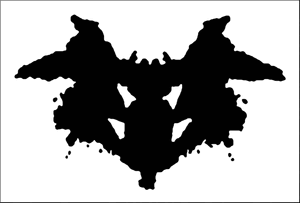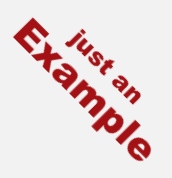(provide reference) |
(add material by critics) |
||
| Line 1: | Line 1: | ||
{{AssessPsy}} |
{{AssessPsy}} |
||
[[Image:inkblot.gif|thumb|300px|right|A solid tone rendering of the first of ten cards in the Rorschach inkblot test.]]The '''Rorschach inkblot test''' <!-- I dispute this pronunciation, a German would say 'roarshach' ch as in loch --> is a method of [[psychology|psychological]] evaluation. Psychologists use this test to try to examine the personality characteristics and emotional functioning of their patients. The Rorschach is currently the second most commonly used test in forensic assessment, after the [[MMPI]], and has been employed in diagnosing underlying thought disorder and differentiating [[psychotic]] from nonpsychotic thinking in cases where the patient is reluctant to openly admit to psychotic thinking.<ref name=Meloy> Meloy, J. Reid, Gacano, C.B. "Rorschach Assessment of Aggressive and Psychopathic Personalities". Mahwah, New Jersey: Lawrence Erlbaum Associates, 1994. ISBN 0805809805.</ref> |
[[Image:inkblot.gif|thumb|300px|right|A solid tone rendering of the first of ten cards in the Rorschach inkblot test.]]The '''Rorschach inkblot test''' <!-- I dispute this pronunciation, a German would say 'roarshach' ch as in loch --> is a method of [[psychology|psychological]] evaluation. Psychologists use this test to try to examine the personality characteristics and emotional functioning of their patients. The Rorschach is currently the second most commonly used test in forensic assessment, after the [[MMPI]], and has been employed in diagnosing underlying thought disorder and differentiating [[psychotic]] from nonpsychotic thinking in cases where the patient is reluctant to openly admit to psychotic thinking.<ref name=Meloy> Meloy, J. Reid, Gacano, C.B. "Rorschach Assessment of Aggressive and Psychopathic Personalities". Mahwah, New Jersey: Lawrence Erlbaum Associates, 1994. ISBN 0805809805.</ref> |
||
| + | |||
| + | |||
| + | The '''Rorschach inkblot test''' (pronounced {{IPA2|ʁoɐʃax}}) is a method of [[psychology|psychological]] evaluation. Psychologists use this test to try to examine the personality characteristics and emotional functioning of their patients. The Rorschach is currently the second most commonly used test in [[Forensic psychology|forensic assessment]], after the [[MMPI]], and is the second most widely used test by members of the Society for Personality Assessment. It has been employed in diagnosing underlying thought disorder and differentiating [[psychotic]] from nonpsychotic thinking in cases where the patient is reluctant to openly admit to psychotic thinking.<ref name=Meloy> Meloy, J. Reid, Gacano, C.B. "Rorschach Assessment of Aggressive and Psychopathic Personalities". Mahwah, New Jersey: Lawrence Erlbaum Associates, 1994. ISBN 0805809805.</ref> |
||
| + | |||
| + | Critics of the test have raised questions about the extraction of objective meaning from responses to [[inkblot]]s; the [[objectivity]] of psychologists administrating the test; [[inter-rater reliability]]; the verifiability and general [[validity]] of the test; [[bias]] of the test's [[pathology]] scales towards greater numbers of responses; the limited number of psychological conditions which it accurately diagnoses; the inability to replicate the test's [[norm]]s; its use in court-ordered evaluations; and the proliferation of the ten inkblot images, potentially invalidating the test for those who have been exposed to them. The [[Exner system of scoring]] has addressed many of these criticisms with an extensive body of research.<ref>Exner, J.E. (2002). The Rorschach: Basic Foundations and Principles of Interpretation: Volume 1. Hoboken, NJ: Wiley. ISBN 0471386723</ref> |
||
==History== |
==History== |
||
Revision as of 20:23, 25 November 2007
Assessment |
Biopsychology |
Comparative |
Cognitive |
Developmental |
Language |
Individual differences |
Personality |
Philosophy |
Social |
Methods |
Statistics |
Clinical |
Educational |
Industrial |
Professional items |
World psychology |
Social Processes: Methodology · Types of test

A solid tone rendering of the first of ten cards in the Rorschach inkblot test.
The Rorschach inkblot test is a method of psychological evaluation. Psychologists use this test to try to examine the personality characteristics and emotional functioning of their patients. The Rorschach is currently the second most commonly used test in forensic assessment, after the MMPI, and has been employed in diagnosing underlying thought disorder and differentiating psychotic from nonpsychotic thinking in cases where the patient is reluctant to openly admit to psychotic thinking.[1]
The Rorschach inkblot test (pronounced IPA: [ʁoɐʃax]) is a method of psychological evaluation. Psychologists use this test to try to examine the personality characteristics and emotional functioning of their patients. The Rorschach is currently the second most commonly used test in forensic assessment, after the MMPI, and is the second most widely used test by members of the Society for Personality Assessment. It has been employed in diagnosing underlying thought disorder and differentiating psychotic from nonpsychotic thinking in cases where the patient is reluctant to openly admit to psychotic thinking.[1]
Critics of the test have raised questions about the extraction of objective meaning from responses to inkblots; the objectivity of psychologists administrating the test; inter-rater reliability; the verifiability and general validity of the test; bias of the test's pathology scales towards greater numbers of responses; the limited number of psychological conditions which it accurately diagnoses; the inability to replicate the test's norms; its use in court-ordered evaluations; and the proliferation of the ten inkblot images, potentially invalidating the test for those who have been exposed to them. The Exner system of scoring has addressed many of these criticisms with an extensive body of research.[2]
History
The Rorschach inkblot test was developed by Hermann Rorschach, a Swiss psychiatrist and proponent of psychoanalysis, in the early twentieth century. Rorschach devised the ten standardised cards used today as well as a scoring system. Rorschach considered his test to be a test of "perception and apperception" rather than imagination. Rorschach's original scoring system emphasizes perceptual factors - for example whether a response is influenced by form, perceived movement, or color of the blot.
After Rorschach's death the original scoring system was developed further by, amongst others, Bruno Klopfer. John E. Exner summarized some of these later developments in the comprehensive Exner system, at the same time trying to make the scoring more statistically rigorous. Most systems are based on the psychoanalytic concept of object relations.
The Exner system is very popular in the United States, while in Europe the textbook by Evald Bohm, which is closer to the original Rorschach system as well as more inspired by psychoanalysis is often considered to be the standard reference work.
Methods
There are ten official inkblots. Five inkblots are black ink on white. Two are black and red ink on white. Three are multicolored. The psychologist shows the inkblots in a particular order and asks the patient, for each card, "What might this be?". After the patient has seen and responded to all the inkblots, the psychologist then gives them to him again one at a time to study. The patient is asked to list everything he sees in each blot, where he sees it, and what there is in the blot that makes it look like that. The blot can also be rotated. As the patient is examining the inkblots, the psychologist writes down everything the patient says or does, no matter how trivial. The psychologist also times the patient which then factors into the overall assessment.
Methods of interpretation differ. The most widely used method in the United States is based on the work of John E. Exner. In the Exner system, responses are scored with reference to their level of vagueness or synthesis of multiple images in the blot, the location of the response, which of a variety of determinants is used to produce the response (for example, whether the shape of the inkblot, its color, or its texture is primary in making it look like what it is said to resemble), the form quality of the response (to what extent a response is faithful to how the actual inkblot looks), the contents of the response (what the respondent actually sees in the blot), the degree of mental organizing activity that is involved in producing the response, and any illogical, incongruous, or incoherent aspects of responses.
Using the scores for these categories, the examiner then performs a series of mathematical calculations producing a structural summary of the test data. The results of the structural summary are interpreted using existing empirical research data on personality characteristics that have been demonstrated to be associated with different kinds of responses. Both the calculations of scores and the interpretation are often done electronically.
A common misconception of the Rorschach test is that its interpretation is based primarily on the contents of the response- what the examinee sees in the inkblot. In fact, the contents of the response are only a comparatively small portion of a broader cluster of variables that are used to interpret the Rorschach data.
The Rorschach inkblot test is controversial for two reasons.
First, because the blots of ink are inherently meaningless and subjective, evaluating the results of a test requires the blots of ink to have meaning in the first place. Otherwise, the images projected into the patterns would be of little value in assessing personality traits. Supporters of the Rorschach inkblot test believe that the subject's response to an ambiguous and meaningless stimulus can provide insight into thought processes.
But the psychologist must project onto the patterns in order to give them any meaning and, in a sense, take the test him/herself. So the results of any test will not only show what the patient projected onto the ink blots, but also what the psychologist projected onto the projections of the patient. Third parties could be called in to evaluate what effect the psychologist's interpretations had on the results of the test, but the third parties' evaluations would also be slanted by their own subconscious interpretations of meaningless patterns. The process of evaluating and re-evaluating could go on forever.
When interpreted as a projective test, results are poorly verifiable. The Exner system of scoring, which interprets the test in terms of what factor (shading, color, outline, etc.) of the inkblot leads to each of the tested person's comments, is meant to address this, but problems of test validity remain. However, there is substantial research indicating the utility of the measure for detecting such conditions as thought disorders, mood and anxiety disorder, personality disorders, and psychopathy.
Supporters of the test try to keep the actual cards secret so that the answers are spontaneous. This practice is consistent with the American Psychological Association's ethical standards of preserving test security. The official test is sold only to licensed professionals. These ethics were violated first by William Poundstone in his book Big Secrets (1983), which described the method of administering the test and gave outlines of the ten official images. In 2004, the images were leaked to the Internet.[3] This reduced the value of projective testing for those individuals who have become familiar with the material, potentially negatively impacting their care. The Rorschach Society claims the blots are copyrighted; this has been disputed by others who state that the blots should be in the public domain legally based upon when they were first created and how long Rorschach has been dead (over 80 years).
References
- ↑ 1.0 1.1 Meloy, J. Reid, Gacano, C.B. "Rorschach Assessment of Aggressive and Psychopathic Personalities". Mahwah, New Jersey: Lawrence Erlbaum Associates, 1994. ISBN 0805809805.
- ↑ Exner, J.E. (2002). The Rorschach: Basic Foundations and Principles of Interpretation: Volume 1. Hoboken, NJ: Wiley. ISBN 0471386723
- ↑ See: http://www.deltabravo.net/custody/rorschach.php
See also
References
- "Rorschach technique" entry in the Gale Encyclopedia of Psychology
- The Skeptic's Dictionary article criticizing the test
- "Giving up Cherished Ideas: The Rorschach Ink Blot Test" by Robyn M. Dawes, IPT Journal, Fall 1991
- "presentation and promotion of the Rorschach method, concentrating on the way it has been practiced within the classical European tradition"
External links
- International Rorschach Society
- History of Inkblot Techniques
- The secret test blot set and all operational procedures
- The Rorschach Inkblot Test, Fortune Tellers, and Cold Reading
- Unofficial Rorschach website
- Using inkblots to create secure passwords
- An online inkblot generator
| This page uses Creative Commons Licensed content from Wikipedia (view authors). |

